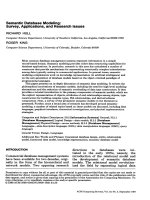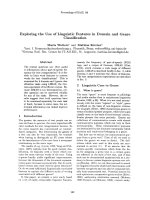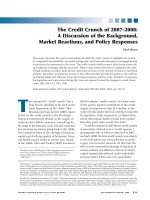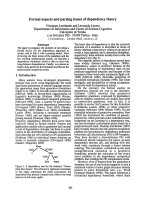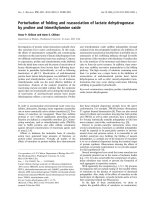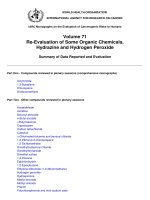STUDIES OF WELFARE POPULATIONS Data Collection and Research Issues potx
Bạn đang xem bản rút gọn của tài liệu. Xem và tải ngay bản đầy đủ của tài liệu tại đây (6.28 MB, 539 trang )
Panel on Data and Methods for Measuring the Effects of
Changes in Social Welfare Programs
Michele Ver Ploeg, Robert A. Moffitt, and Constance F. Citro,
Editors
Committee on National Statistics
Division of Behavioral and Social Sciences and Education
National Research Council
NATIONAL ACADEMY PRESS
Washington, DC
WELFARE POPULATIONS
STUDIES OF
Data Collection and Research Issues
NATIONAL ACADEMY PRESS • 2101 Constitution Avenue, N.W. • Washington, DC 20418
NOTICE: The project that is the subject of this report was approved by the Governing Board of the
National Research Council, whose members are drawn from the councils of the National Academy of
Sciences, the National Academy of Engineering, and the Institute of Medicine. The members of the
committee responsible for the report were chosen for their special competences and with regard for
appropriate balance.
This study was supported by Contract No. HHS-100-98-0011 between the National Academy of
Sciences and the U.S. Department of Health and Human Services. Support of the work of the Com-
mittee on National Statistics is provided by a consortium of federal agencies through a grant from the
National Science Foundation (Number SBR-9709489). Any opinions, findings, conclusions, or rec-
ommendations expressed in this publication are those of the author(s) and do not necessarily reflect
the views of the organizations or agencies that provided support for the project.
Library of Congress Cataloging-in-Publication Data
Studies of welfare populations : data collection and research issues :
Panel on Data and Methods for Measuring the Effects of Changes in Social
Welfare Programs / Michele Ver Ploeg, Robert A. Moffitt, and
Constance F. Citro, editors ; Committee on National Statistics, Division of
Behavioral and Social Sciences and Education, National Research Council.
p. cm.
Includes bibliographical references and index.
ISBN 0-309-07623-4 (pbk.)
1. Public welfare—Statistical methods. 2. Social surveys. 3. Public
welfare—Research—Methodology. I. Ver Ploeg, Michele. II. Moffitt,
Robert A. III. Citro, Constance F. (Constance Forbes), 1942- IV. Panel
on Data and Methods for Measuring the Effects of Changes in Social
Welfare Programs (U.S.)
HV29 .S78 2002
362.5′8′072—dc21
2001005893
Additional copies of this report are available from the National Academy Press, 2101 Constitution
Avenue, N.W., Lockbox 285, Washington, DC 20055; (800) 624-6242 or (202) 334-3313 (in the
Washington metropolitan area); Internet,
Printed in the United States of America
Copyright 2002 by the National Academy of Sciences. All rights reserved.
Suggested citation: Studies of Welfare Populations: Data Collection and Research Issues (2002).
Panel on Data and Methods for Measuring the Effects of Changes in Social Welfare Programs,
Michele Ver Ploeg, Robert A. Moffitt, and Constance F. Citro, Editors. Committee on National
Statistics, Division of Behavioral and Social Sciences and Education. Washington, DC: National
Academy Press.
The National Academy of Sciences is a private, nonprofit, self-perpetuating society of
distinguished scholars engaged in scientific and engineering research, dedicated to the
furtherance of science and technology and to their use for the general welfare. Upon the
authority of the charter granted to it by the Congress in 1863, the Academy has a mandate
that requires it to advise the federal government on scientific and technical matters. Dr.
Bruce M. Alberts is president of the National Academy of Sciences.
The National Academy of Engineering was established in 1964, under the charter of the
National Academy of Sciences, as a parallel organization of outstanding engineers. It is
autonomous in its administration and in the selection of its members, sharing with the
National Academy of Sciences the responsibility for advising the federal government. The
National Academy of Engineering also sponsors engineering programs aimed at meeting
national needs, encourages education and research, and recognizes the superior achieve-
ments of engineers. Dr. Wm. A. Wulf is president of the National Academy of Engineer-
ing.
The Institute of Medicine was established in 1970 by the National Academy of Sciences
to secure the services of eminent members of appropriate professions in the examination
of policy matters pertaining to the health of the public. The Institute acts under the respon-
sibility given to the National Academy of Sciences by its congressional charter to be an
adviser to the federal government and, upon its own initiative, to identify issues of medical
care, research, and education. Dr. Kenneth I. Shine is president of the Institute of Medi-
cine.
The National Research Council was organized by the National Academy of Sciences in
1916 to associate the broad community of science and technology with the Academy’s
purposes of furthering knowledge and advising the federal government. Functioning in
accordance with general policies determined by the Academy, the Council has become the
principal operating agency of both the National Academy of Sciences and the National
Academy of Engineering in providing services to the government, the public, and the
scientific and engineering communities. The Council is administered jointly by both Acad-
emies and the Institute of Medicine. Dr. Bruce M. Alberts and Dr. Wm. A. Wulf are
chairman and vice chairman, respectively, of the National Research Council.
National Academy of Sciences
National Academy of Engineering
Institute of Medicine
National Research Council
v
PANEL ON DATA AND METHODS FOR MEASURING THE EFFECTS
OF CHANGES IN SOCIAL WELFARE PROGRAMS
ROBERT A. MOFFITT (Chair), Department of Economics, Johns Hopkins
University
JOHN L. ADAMS, RAND, Santa Monica, California
THOMAS CORBETT, Institute for Research on Poverty, University of
Wisconsin, Madison
JOHN L. CZAJKA, Mathematica Policy Research, Inc., Washington, D.C.
KATHRYN EDIN, Institute for Policy Research, Northwestern University
IRWIN GARFINKEL, School of Social Work, Columbia University
ROBERT M. GOERGE, Chapin Hall Center for Children, University of
Chicago
ERIC A. HANUSHEK, Hoover Institution, Stanford University
V. JOSEPH HOTZ, Departments of Economics and Policy Studies, University
of California, Los Angeles
RICHARD A. KULKA, Statistics, Health, and Social Policy, Research
Triangle Institute, Research Triangle Park, NC
REBECCA A. MAYNARD, Graduate School of Education, University of
Pennsylvania
SUZANNE M. RANDOLPH, Department of Family Studies, University of
Maryland
WERNER SCHINK, California Department of Social Services, Sacramento
MICHELE VER PLOEG, Study Director
CONSTANCE F. CITRO, Senior Program Officer
MICHAEL SIRI, Project Assistant
vi
COMMITTEE ON NATIONAL STATISTICS
2001
JOHN E. ROLPH (Chair), Marshall School of Business, University of
Southern California
JOSEPH G. ALTONJI, Department of Economics, Northwestern University
ROBERT BELL, AT&T Laboratories-Research, Florham Park, NJ
LAWRENCE D. BROWN, Department of Statistics, University of
Pennsylvania
ROBERT M. GROVES, Joint Program in Survey Methodology, University of
Michigan
HERMANN HABERMANN, Statistics Division, United Nations
JOEL L. HOROWITZ, Department of Economics, University of Iowa
WILLIAM KALSBEEK, Department of Biostatistics, University of North
Carolina
ARLEEN LEIBOWITZ, School of Public Policy and Social Research,
University of California, Los Angeles
RODERICK J.A. LITTLE, School of Public Health, University of Michigan
THOMAS A. LOUIS, RAND, Arlington, VA
DARYL PREGIBON, AT&T Laboratories-Research, Florham Park, NJ
NORA CATE SCHAEFFER, Sociology Department, University of Wisconsin-
Madison
MATTHEW D. SHAPIRO, Department of Economics, University of Michigan
ANDREW A. WHITE, Director
vii
Acknowledgments
This volume is the product of the hard work of many individuals to whom we
are grateful. We would first like to thank the authors of papers for their contribu-
tions and for presenting the papers at the workshop or at meetings of the panel.
Each of these papers was reviewed by members of the panel and outside review-
ers. Most of these reviewers were also discussants at the workshop on Data
Collection for Low Income and Welfare Populations held December 16-17, 1999.
We are indebted to all reviewers for their constructive comments to the authors:
Sandra Berry, Rand; Harold Bloom, Manpower Demonstration Research Corpo-
ration; Mike Brick, Westat; Sheldon Danziger, University of Michigan; Betsy
Martin, U.S. Census Bureau; Daniel McCaffrey, RAND; Charles Metcalf,
Mathematica Policy Research; Jeffrey Moore, U.S. Census Bureau; John Karl
Scholz, University of Wisconsin-Madison; Matthew Stagner, Urban Institute;
William Winkler, U.S. Census Bureau; and Laura Zayatz, U.S. Census Bureau. I
would also like to thank my fellow members of the Panel on Data and Methods
for Measuring the Effects of Changes in Social Welfare Programs for helping to
shape the topics of the papers, developing the workshop, and reviewing the
papers. Graham Kalton, Westat, and Robert Groves, University of Michigan,
should also be thanked for helping the panel identify authors and discussants for
these papers.
I would like to thank the staff of the Committee on National Statistics for
their work on this volume. I would like to thank my coeditors, Michele Ver Ploeg
and Constance F. Citro, for their diligence in polishing the papers and guiding
them through the review process. The production of this volume could not be
possible without the efforts of Michael Siri, project assistant for the Committee
viii ACKNOWLEDGMENTS
on National Statistics. Michael did an excellent job on the difficult task of getting
14 papers with14 different formats into a common format for the volume. All of
these papers were professionally edited by Laura Penney, to which we are also
grateful. Yvonne Wise of the Division of Behavioral and Social Sciences of the
National Research Council is to be thanked for her assistance in shepherding the
report through the phases of production.
Finally, we are also grateful to the Office of the Assistant Secretary for
Planning and Evaluation in the Department of Health and Human Services for its
sponsorship of the panel that made this volume possible.
Robert A. Moffitt, Chair
Panel on Data and Methods for
Measuring the Effects of Changes
in Social Welfare Programs
ix
Contents
INTRODUCTION 1
Robert A. Moffitt, Constance F. Citro, and Michele Ver Ploeg
PART I SURVEY DATA
1 Designing Surveys Acknowledging Nonresponse 13
Robert M. Groves and Mick P. Couper
2 Methods for Obtaining High Response Rates in Telephone Surveys 55
David Cantor and Patricia Cunningham
3 High Response Rates for Low-Income Population In-Person Surveys 86
Charlene Weiss and Barbara A. Bailar
4 Paying Respondents for Survey Participation 105
Eleanor Singer and Richard A. Kulka
5 Adjusting for Missing Data in Low-Income Surveys 129
Leyla Mohadjer and G. Hussain Choudhry
6 Measurement Error in Surveys of the Low-Income Population 157
Nancy A. Mathiowetz, Charlie Brown, and John Bound
PART II ADMINISTRATIVE DATA
7 Matching and Cleaning Administrative Data 197
Robert M. Goerge and Bong Joo Lee
x CONTENTS
8 Access and Confidentiality Issues with Administrative Data 220
Henry E. Brady, Susan A. Grand, M. Anne Powell, and
Werner Schink
9 Measuring Employment and Income for Low-Income
Populations with Administrative and Survey Data 275
V. Joseph Hotz and John Karl Scholz
10 Administrative Data on the Well-Being of Children
On and Off Welfare 316
Richard Barth, Eleanor Locklin-Brown, Stephanie
Cuccaro-Alamin, and Barbara Needell
PART III QUALITATIVE DATA
11 The Right (Soft) Stuff: Qualitative Methods and the Study of Welfare
Reform 355
Katherine S. Newman
PART IV WELFARE LEAVERS AND WELFARE DYNAMICS
12 Studies of Welfare Leavers: Data, Methods, and Contributions to the
Policy Process 387
Gregory Acs and Pamela Loprest
13 Preexit Benefit Receipt and Employment Histories and
Postexit Outcomes of Welfare Leavers 415
Michele Ver Ploeg
14 Experienced-Based Measures of Heterogeneity in the
Welfare Caseload 473
Robert A. Moffitt
Appendix: Agenda of the Workshop on Data Collection for
Low-Income and Welfare Populations 501
Index 507
WELFARE POPULATIONS
STUDIES OF
1
Introduction
Robert A. Moffitt, Constance F. Citro, and Michele Ver Ploeg
Academic and policy interest in the U.S. welfare system has increased dra-
matically over the past 15 years, an interest that has accelerated and is currently
at an all-time high. Beginning in the late 1980s with welfare reform initiatives in
a few states around the country and continuing in the first half of the 1990s as
more states made changes in their income support programs, welfare reform
culminated at the federal level with the passage of the Personal Responsibility
and Work Opportunity Reconciliation Act (PRWORA) in 1996. PRWORA re-
placed the long-standing federal entitlement program for low-income families
and children (Aid to Families with Dependent Children, AFDC) with a program
financed by state-administered block grants, the Temporary Assistance for Needy
Families (TANF) program. The legislation imposed several new requirements on
state TANF programs, including lifetime limits on receipt of benefits, minimum
work requirements, and requirements for unmarried teenage parents to reside
with an adult and continue their education in order to receive benefits. Otherwise,
it allowed states to configure their programs as they see fit, continuing a trend of
devolving the design and control of familial assistance programs from the federal
government to state governments that began earlier in the 1990s.
The enactment of PRWORA provided the impetus for a large volume of
research studies aimed at studying its impact and that of changes in other federal
income support programs, such as the Food Stamp Program. These studies are
now yielding results and reporting new findings on an almost-daily basis.
PRWORA is slated to come up for reauthorization in 2002, and it is already clear
that research findings will play a significant role in the debate over the directions
that welfare reform should take from here.
2 INTRODUCTION
The Panel on Data and Methods for Measuring the Effects of Changes in
Social Welfare Programs of the National Research Council was formed in 1998
to review the evaluation methods and data that are needed to study the effects of
welfare reform. Sponsored by the Office of the Assistant Secretary for Planning
and Evaluation (ASPE) of the U.S. Department of Health and Human Services
through a congressional appropriation, the panel has issued interim and final
reports (National Research Council, 1999, 2001).
Early in its deliberations, particularly after reviewing the large number of so-
called “welfare leaver” studies—studies of how families who left the TANF rolls
were faring off welfare—the panel realized that the database for conducting
studies of welfare reform had many deficiencies and required attention by policy
makers and research analysts. In its final report, the panel concluded that welfare
reform evaluation imposes significant demands on the data infrastructure for
welfare and low-income populations and that “. . . inadequacies in the nation’s
data infrastructure for social welfare program study constitutes the major barrier
to good monitoring and evaluation of the effects of reform” (NRC 2001:146).
The panel concluded that national-level surveys were being put under great strain
for PRWORA research given their small sample sizes, limited welfare policy-
related content, and, often, high rates of nonresponse (see also National Research
Council, 1998). State-level administrative data sets, the panel concluded, are of
much more importance with the devolution of welfare policy but are difficult to
use for research because they were designed for management purposes. In addi-
tion, although they have large sample sizes, their content is limited. Surveys for
specific states with more detailed content have been only recently attempted—
usually telephone surveys of leavers—and the panel expressed concern about the
capacity and technical expertise of state governments to conduct such surveys of
adequate quality. To date, for example, many surveys of welfare leavers have
unacceptably high rates of nonresponse. Overall, the panel concluded that major
new investments are needed in the data infrastructure for analysis of welfare and
low-income populations.
This concern led the panel to plan a workshop on data collection on welfare
and low-income populations for which experts would be asked to write papers
addressing in detail not only what the data collection issues are for this popula-
tion, but also how the quality and quantity of data can be improved. A workshop
was held on December 16-17, 1999, in Washington, DC. The agenda for the
workshop is listed as an Appendix to this volume. Approximately half the papers
presented at the workshop concerned survey data and the other half concerned
administrative data; one paper addressed qualitative data. Altogether, the papers
provide a comprehensive review of relevant types of data. The volume also
contains four additional papers that were commissioned to complement the con-
ference papers. One of them discusses methods for adjusting survey data for
nonresponse. The other three papers focus on welfare leavers, a subpopulation of
particular interest to Congress that a number of states have studied with grants
ROBERT A. MOFFITT, CONSTANCE F. CITRO, AND MICHELE VER PLOEG 3
from ASPE, as well as the importance of understanding the dynamics of the
welfare caseload when interpreting findings from these studies.
After the conference, the papers were revised, following National Research
Council procedures, to reflect the comments of discussants at the workshop,
panel members, and outside reviewers. The additional commissioned papers also
were revised in response to comments from panel members and outside review-
ers. This volume contains the final versions of the papers.
In this introduction, we summarize each of the 14 papers in the volume.
Together, they are intended as a guide and reference tool for researchers and
program administrators seeking to improve the availability and quality of data on
welfare and low-income populations for state-level, as well as national-level,
analysis.
SURVEY DATA
The volume contains six papers on survey issues. They address (1) methods
for designing surveys taking into account nonresponse in advance; (2) methods
for obtaining high response rates in telephone surveys; (3) methods for obtaining
high response rates in in-person surveys; (4) the effects of incentive payments;
(5) methods for adjusting for missing data in surveys of low-income populations;
and (6) measurement error issues in surveys, with a special focus on recall error.
In their paper on “Designing Surveys Acknowledging Nonresponse,” Groves
and Couper first review the basic issues involved in nonresponse, illustrating the
problem of bias in means and other statistics, such as differences in means and
regression coefficients, and how that bias is related to the magnitude of non-
response and the size of the difference in outcomes between respondents and
nonrespondents. They also briefly review methods of weighting and imputation
to adjust for nonresponse after the fact. The authors then discuss the details of the
survey process, including the exact process of contacting a respondent and how
barriers to that contact arise, noting that welfare reform may generate additional
barriers (e.g., because welfare recipients are more likely to be working and hence
not at home). They also provide an in-depth discussion of the respondent’s deci-
sion to participate in a survey, noting the importance of the environment, the
respondent, and the survey design itself, and how the initial interaction between
survey taker and respondent is a key element affecting the participation decision.
They propose a fairly ambitious process of interviewer questioning, which in-
volves contingent reactions to different statements by the respondent, a process
that would require expert interviewers. They conclude with a list of 10 principles
for surveys of the low-income population for improvement in light of non-
response.
Cantor and Cunningham discuss methods for obtaining high response rates
in telephone surveys of welfare and low-income populations in their paper, first
identifying “best practices” and then comparing those to practices used in some
4 INTRODUCTION
welfare leaver telephone surveys. The authors note the overriding importance of
recognizing language and cultural diversity among respondents and the need to
take such diversity into account in designing content and deploying interviewers.
They then discuss specific issues in increasing response rates, including obtain-
ing contact information in the presurvey process (e.g., from administrative rec-
ords); obtaining informed consent to gather information needed for subsequent
tracking; address-related problems with mail surveys; methods for tracing hard-
to-locate respondents; dealing with answering machines; the importance of highly
trained interviewers, echoing the emphasis of Groves and Couper; considerations
in questionnaire design, including the critical nature of the introduction; and
refusal conversion. Cantor and Cunningham then review a set of telephone sur-
veys of welfare recipients and welfare leavers. They find that response rates often
are quite low and that use of the telephone alone only rarely will obtain response
rates greater than 50 percent, which is a very low number by the traditional
standards of survey research. They suggest that higher, acceptable response rates
will almost surely require substantial in-person followup, which can move the
response rate up above 70 percent. The authors note that nonresponse is mainly
an issue of inability to locate respondents rather than outright refusals, which
makes tracing and locating respondents of great importance. They find that many
welfare records are of poor quality to assist in tracing, containing inaccurate and
out-of-date locator information, and they emphasize that expertise in tracing is
needed in light of the difficulties involved. Refusal conversion is also discussed,
with an emphasis again on the need for trained interviewers in using this method.
Finally, the authors discuss random-digit dialing telephone surveys of this popu-
lation (as opposed to surveys based on list samples such as those from welfare
records) and explore the additional difficulties that arise with this methodology.
The paper by Weiss and Bailar discusses methods for obtaining high re-
sponse rates from in-person surveys of the low-income population. The prin-
ciples are illustrated with five in-person surveys of this population conducted by
the National Opinion Research Certer (NORC). All the surveys drew their samples
from administrative lists, provided monetary incentives for survey participation,
and applied extensive locating methods. Among the issues discussed are the
importance of the advance letter, community contacts, and an extensive tracing
and locating operation, including field-based tracing on top of office-based tracing.
The authors also provide an in-depth discussion of the importance of experienced
interviewers for this population, including experience not only in administering
an interview, but also in securing cooperation with the survey. The use of travel-
ing interviewers and the importance of good field supervisory staff and site
management are then addressed.
In their paper, Singer and Kulka review what is known about the effects of
paying respondents for survey participation (“incentives”). Reviewing both mail
and telephone surveys, the authors report that incentives are, overall, effective in
increasing response rates; that prepaid incentives are usually more effective than
ROBERT A. MOFFITT, CONSTANCE F. CITRO, AND MICHELE VER PLOEG 5
promised incentives; that money is more important than a gift; and that incentives
have a greater effect when respondent burden is high and the initial response rate
is low. They also note that incentives appear to be effective in panel surveys, even
when incentives are not as high in subsequent waves of interviews as they are in
the initial wave. After discussing the evidence on whether incentives affect item
nonresponse or the distribution of given responses—the evidence on the issue is
mixed—the authors review what little is known about the use of incentives in
low-income populations. The little available evidence suggests, again, that incen-
tives are effective in this population as well. The authors conclude with a number
of recommendations on the use of incentives, including a recommendation that
payments to convert initial refusals to interviews be made sparingly.
Mohadjer and Choudhry provide an exposition of methods for adjusting for
missing data after the fact—that is, after the data have been collected. Their paper
focuses on traditional weighting methods for such adjustment and includes meth-
ods for adjustment for noncoverage of the population as well as nonresponse to
the survey. The authors present basic weighting methods and give examples of
how variables are used to construct weights. They also discuss the effect of using
weights derived from the survey sample versus weights obtained from outside
data sets on the population as a whole. For population-based weights, they dis-
cuss issues of poststratification and raking that arise. Finally, they provide a brief
discussion of the bias-variance tradeoff in designing weights, which is intrinsic to
the nature of weights.
Measurement error is discussed in the paper by Mathiowetz, Brown, and
Bound. The paper first lists the sources of measurement error in the survey
process, which include the questionnaire itself; the respondent; the interviewer;
and the conditions of the survey (interviewer training, mode, frequency of mea-
surement, etc.). The authors then review issues relating to the cognitive aspects of
measurement error and provide an extended discussion of the problem of ques-
tions requiring autobiographical memory. Other topics discussed in the paper
include the issue of social desirability of a particular response; errors in response
to sensitive questions; and errors in survey reports of earnings and income. A
number of existing studies of measurement error are reviewed, but none are
focused on welfare or low-income populations per se or on populations with
unstable income and employment streams. The authors point out how earnings
reports need to be based on salient events and give examples in which such
salience is absent. A detailed review is then provided of what is known about
measurement error in reports of transfer program income, child support income,
hours of work, and unemployment histories. Finally, the authors list a number of
issues that should be addressed that can help reduce measurement error, includ-
ing proper attention by cognitive experts to comprehension of the question by
respondents, care for the process of retrieval when writing questions, the use of
calendars and landmark events, and a number of other questionnaire design top-
ics. Methods for asking socially sensitive questions also are discussed.
6 INTRODUCTION
ADMINISTRATIVE DATA
Administrative records can be a valuable source of information about the
characteristics and experiences of welfare program beneficiaries and past benefi-
ciaries. To comply with federally mandated time limits on receipt of TANF
benefits, states will need to develop the capability to track recipients over time,
something not usually done in the old AFDC system. Such longitudinal tracking
capability should make program records more useful for analysis; however, dif-
ferences in programs across states will likely make it harder to conduct cross-
state analyses. Research use of administrative records, whether TANF records or
records from other systems (e.g., Unemployment Insurance) that can be used to
track selected outcomes for welfare and low-income populations, poses many
challenges.
Four papers on administrative data covering a wide range of different topics
are included in the volume. The four address (1) issues in the matching and
cleaning of administrative data; (2) issues of access and confidentiality; (3) prob-
lems in measuring employment and income with administrative data compared to
survey data; and (4) the availability of administrative data on children.
Issues in the matching and cleaning of administrative data are discussed by
Goerge and Lee. The authors begin by noting the importance of “cleaning” ad-
ministrative data in a comprehensive sense, namely, converting what are manage-
ment files into analytic files suitable for research use. They also note the impor-
tance of matching records across multiple administrative data sets (i.e., record
linkage), which provides more information on respondents. A number of issues
are involved in the cleaning process, many of which involve methods for assess-
ing data quality and other aspects of the variables available in the administrative
data. A number of important issues in record linkage also are discussed, perhaps
the most important being the availability and accuracy of matching variables. The
authors discuss deterministic and probabilistic record linkage as well as data
quality issues in such linkage. The paper concludes with a number of recommen-
dations on the cleaning and linking of administrative data.
Brady, Grand, Powell, and Schink discuss access and confidentiality issues
with administrative data in their paper and propose ways for increasing researcher
access to administrative data. The authors begin by noting that the legal barriers
to obtaining access to administrative data by researchers often are formidable.
Although laws in this area generally are intended to apply to private individuals
interested in identifying specific persons, researcher access often is denied even
though the researcher has no interest in identities and often intends to use the
research results to help improve administration of the program. The authors
provide a brief overview of the legal framework surrounding administrative data,
confidentiality, and privacy, making a number of important distinctions between
different types of issues and clarifying the content of several pieces of legisla-
tion—federal and state—governing access and confidentiality. They then turn to
ROBERT A. MOFFITT, CONSTANCE F. CITRO, AND MICHELE VER PLOEG 7
a review of how 14 ASPE-funded state welfare leaver studies have dealt with
these issues and whether general lessons can be learned. The authors conclude
that while success in dealing with access and confidentiality problems has been
achieved in many cases, the methods for doing so are ad hoc, based on long-
standing relationships of trust between state agencies and outside researchers,
and not buttressed and supported by an adequate legal framework. Twelve key
principles are laid out for governing data access and confidentiality. Finally, the
authors recommend more use of masking methods as well as institutional mecha-
nisms such as secure data centers to facilitate responsible researcher access to and
use of confidential administrative data.
Hotz and Scholz review the measurement of employment and income from
administrative data and discuss why and whether measures taken from adminis-
trative data differ from those obtained from survey data. Employment and in-
come are, of course, two of the key outcome variables for welfare reform evalu-
ation and hence assume special importance in data collection. They find that there
often are differences in administrative and survey data reports of employment
and income and that the differences are traceable to differences in population
coverage, in reporting units, in sources of income, in measurement error, and in
incentives built into the data-gathering mechanism. The authors provide a de-
tailed review of the quality of employment and income data from, first, the major
national survey data sets; then from state-level administrative data taken from
Unemployment Insurance records; and, finally, from Internal Revenue Service
records. They review what is known about differences in reports across the three
as well. The authors conclude with several recommendations on reconciling po-
tentially different results from these data sources.
Administrative data on children are discussed in the paper by Barth, Locklin-
Brown, Cuccaro-Alamin, and Needell. The authors first discuss the policy issues
surrounding the effects of welfare reform on children and what the mechanisms
for those effects might be. They identify several domains of child well-being that
conceivably can be measured with administrative data, including health, safety
(child abuse and neglect), education, and juvenile justice. In each area, they find
that a number of different administrative data sets could be matched, in principle,
with welfare records. They identify the exact variables measured in each data set
as well. The authors find that good health measures often are present in various
data sets, but they are often inaccessible to researchers, while child abuse and
neglect data are more often available but have many data quality issues that
require careful attention. Education and juvenile justice data are the least acces-
sible to researchers and also contain variables that would only indirectly measure
the true outcomes of interest. The authors find that privacy and confidentiality
barriers impose significant limitations on access to administrative data on chil-
dren, similar to the finding in the paper by Brady et al.
8 INTRODUCTION
QUALITATIVE DATA
Qualitative data increasingly have been used in welfare program evaluations
and studies. Although there is a fairly long history of the use of process analysis
in formal evaluations, there is less history in using direct observation of study
respondents or even using focus groups. Yet in attempting to learn how current or
former welfare recipients are faring, qualitative data can provide information that
neither survey nor administrative data offer.
The paper by Newman discusses the use of qualitative data for investigating
welfare and low-income populations. Newman notes that qualitative data can
assist in helping to understand the subjective points of view of families in these
populations, provide information on how recipients understand the rules of the
welfare system, uncover unexpected factors that are driving families’ situations,
explore any unintended consequences of a policy change, and focus attention on
the dynamic and constantly changing character of most families in the low-
income population. The author reviews a range of methods, from open-ended
questions in survey questionnaires to focus groups to detailed participant obser-
vation in the field, in each case listing the advantages and disadvantages of the
method. Newman then discusses the use of qualitative data in several recent
welfare reform projects to illustrate how the methods can be used. The author
concludes with a recommendation that additional expertise in qualitative data be
brought into state governments and that the use of these methods increase.
WELFARE LEAVERS AND WELFARE DYNAMICS
An initial focus of concern of policy makers has been the effects of PRWORA
on people who left AFDC and successor TANF programs– “welfare leavers.” In
response to a congressional mandate, ASPE provided grant funds to states and
counties to analyze administrative records and conduct surveys of two cohorts of
welfare leavers. In fiscal year 1998, ASPE provided grant funds to 14 jurisdic-
tions (10 states, the District of Columbia, and 3 counties or groups of counties) to
study welfare leavers. In fiscal year 1999 it provided funds to one state to also
follow welfare leavers, and to six jurisdictions (five states and one county group)
to study those who were either formally or informally diverted from enrolling for
TANF—“divertees.”
In its interim and final report (National Research Council, 1999, 2001), the
panel commented on some problems with leaver studies. These problems include
differences in welfare caseload trends across states, such as faster declines in
welfare rolls in some states than others and earlier program changes in states that
sought AFDC waiver provisions, both of which could affect the comparability of
data for cohorts of welfare leavers defined at a point in time. Also, states do not
define leavers in the same way; for example, some states count “child-only cases”
ROBERT A. MOFFITT, CONSTANCE F. CITRO, AND MICHELE VER PLOEG 9
as leavers and others do not. (In such cases, adult members of a family are not
eligible for benefits but the children are.) The panel also emphasized the need for
leaver studies to categorize sample cases by their previous welfare behavior,
distinguishing between people who had been on welfare for a long period or only
a short period or whether they had been cyclers (i.e., alternating periods of wel-
fare receipt with periods of nonreceipt). To illustrate the problems in welfare
leaver studies and best practice in such analyses, the panel commissioned three
papers.
The first paper on this topic, “Studies of Welfare Leavers: Data, Methods,
and Contributions to the Policy Process” by Acs and Loprest, reviews existing
welfare leaver studies, including those funded by ASPE and others. It describes
the definitions, methods, and procedures used in each study and identifies their
strengths and weaknesses. The paper also compares some findings of leaver
studies across studies that use different methodologies to illustrate points about
comparability.
The second paper, “Preexit Benefit Receipt and Employment Histories and
Postexit Outcomes of Welfare Leavers” by Ver Ploeg, uses data from the state of
Wisconsin to analyze welfare leavers. The analysis breaks the sample members
into “long-termers,” “short-termers,” and “cyclers” and shows that this categori-
zation is important for understanding outcomes for these groups. The paper also
stratifies the sample by work experience prior to leaving welfare and finds that
there are sizable differences in employment outcomes across groups with more
work experience compared to those with less work experience and that such
categorizations also can be useful in understanding outcomes of leavers.
The last paper in this section and the final paper in the collection, “Experi-
ence-Based Measures of Heterogeneity in the Welfare Caseload” by Moffitt, uses
data from the National Longitudinal Survey of Youth to construct measures of
heterogeneity in the welfare population based on the recipient’s own welfare
experience. A number of classifications of women in the U.S. population are used
to characterize the amount of time they have spent on welfare, the number of
welfare spells they have experienced, and the average length of their welfare
spells. The same long-termer, short-termer, and cycler distinctions are used in the
paper as well. The analysis of the characteristics of these groups reveals that
short-termers have the strongest labor market capabilities but, surprisingly, that
cyclers and long-termers are approximately the same in terms of labor market
potential. More generally, the only significant indicator of labor market capabil-
ity is the total amount of time a recipient has been on welfare, not the degree of
turnover or lengths of spells she experiences. The analysis suggests that welfare
cycling is not a very useful indicator of a recipient’s labor market capability and
that the nature of welfare cyclers and reasons that cycling occur are not well
understood.
10 INTRODUCTION
REFERENCES
National Research Council
1998 Providing National Statistics on Health and Social Welfare Programs in an Era of
Change, Summary of a Workshop. Committee on National Statistics. Constance F. Citro,
Charles F. Manski, and John Pepper, eds. Washington, DC: National Academy Press.
1999 Evaluating Welfare Reform: A Framework and Review of Current Work. Panel on Data
and Methods for Measuring the Effects of Changes in Social Welfare Programs. Robert
A. Moffitt and Michele Ver Ploeg, eds. Washington, DC: National Academy Press.
2001 Evaluating Welfare Reform in an Era of Transition. Panel on Data and Methods for
Measuring the Effects of Changes in Social Welfare Programs. Robert A. Moffitt and
Michele Ver Ploeg, eds. Washington, DC: National Academy Press.
Part I
Survey Data
